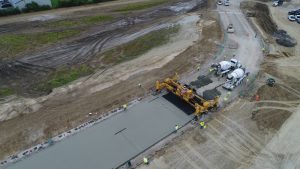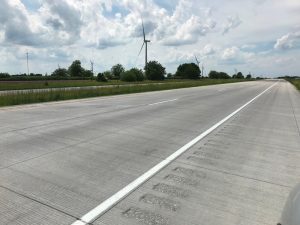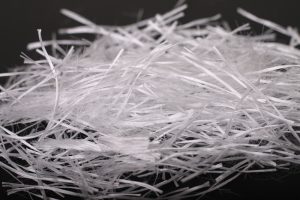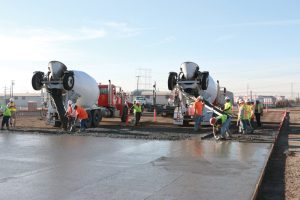As a result of the global pandemic, construction materials such as steel – a necessary material for use in traditional concrete applications – have been impacted by price increases and material shortages. Although this may be concerning for businesses and municipalities undertaking construction projects involving parking decks, roads, bridges, and other concrete-related repairs, it may open up the opportunity to utilize the short-term and long-term benefits of fiber-reinforced concrete.
Selecting Fiber-Reinforced Concrete
Fiber-reinforced concrete (FRC) is a concrete mixture reinforced with randomly oriented fibers. Depending on the project and the environmental impact that may affect the concrete, there are a wide variety of fibers (https://bit.ly/3nMQ91H) that may fit the needs of a specific project.
Examples of some available fibers include:
- Synthetic Macrofibers: Used in applications to replace conventional reinforcing for flooring, precast, and shotcrete applications
- Steel Fibers: Generally used to provide concrete with enhanced toughness and post-crack carrying capacity
- Steel and Micro/Macro Blends: A combination of steel and/or macro-synthetic fibers with various micro-synthetic fibers that help control plastic shrinkage cracking while also providing enhanced toughness and post-crack load carry capacity
- Glass Fibers: Predominantly used in architectural applications and modified cement-based panel structures
- Cellulose Fibers: Processed wood pulp product that is used for the control and mitigation of plastic shrinkage cracking
Over the past several years, there has been increased interest in fiber-reinforced concrete in concrete pavement applications, such as parking lots, bridge decks, and roadways. As a result, organizations like the American Concrete Institute, the American Concrete Pavement Association, and the National Concrete Pavement Technology Center have developed guidelines and recommendations on properly selecting and using fiber in concrete.
FRC is Widely Utilized
While it may seem like a new development in construction, fiber-reinforced concrete has been around for several decades. However, as municipalities and businesses seek a low-cost option that provides durability and the ability to develop state-of-the-art designs, there has been a rise in the use of fiber-reinforced concrete.
For example, SoFi Stadium – the home stadium of the Los Angeles Rams and Chargers – used synthetic macrofiber reinforcement for its topping slabs and crack control. In addition, a concrete overlay with fiber reinforcement was used to rehabilitate 15-lane miles of highway in Fowler, Indiana.
Key Benefits of FRC
Here are the seven key benefits of fiber-reinforced concrete that both designers and customers should consider:
Cost-Effectiveness: According to the National Concrete Pavement Technology Center, “fiber-reinforced concrete can offer a cost-effective, sustainable solution for resurfacing and rehabilitating existing pavements. Either as overlays or full-depth replacement pavements, state DOTs and other engineering groups are rapidly adopting macro-synthetic fibers into their designs, specifications, and experimental projects for road and airfield pavements.”
Fewer Staff Required: With the limitations on available manpower and cost uncertainties affecting the construction industry in today’s economy, fiber-reinforced concrete can offer a safer and more cost-effective working environment that can actually speed up construction while reducing the environmental impact at a project site. From the perspective of safety, fewer personnel on-site and reduced trip hazards are significant benefits and allow for increased placement speed.
Reduced Delays: By subtracting the use of conventional steel rebar, an inspection of the steel placement is not required by a municipality. The concrete would be placed with fiber reinforcing supplied by a concrete provider and installed in the concrete prior to placements. Ready-mix trucks can quickly and efficiently place the concrete at the required project location with minimal finishing practices.
Improved Long-Term Serviceability: Concrete can be susceptible to corrosion, freezing and thawing, attacks by traditional road salt, and penetration of other aggressive solutions. Concrete durability can be improved by minimizing the ability of water and other solutions to penetrate beyond the surface. Fiber-reinforced concrete helps maintain tight crack control, reducing the size of a crack’s width – ultimately preventing water and other solutions from penetrating the concrete. It is important to note that synthetic fibers for concrete do not corrode. Removing conventional steel from concrete, which can corrode and cause accelerated deterioration, is a significant advantage for synthetics as they are designed to be equivalent from an engineered performance perspective. Although steel fibers generally do not corrode either, they can discolor at a surface exposed to air or water. As such, this offers an aesthetic advantage for synthetic fibers.
Temperature and Shrinkage Reinforcement: Fiber-reinforced concrete can be an economically viable alternative to welded wire reinforcement and small diameter bars to guard against temperature and shrinkage issues.
Reduced Cost: Fiber-reinforced concrete can reduce construction times, reduce the cost of labor, and lower maintenance costs, which are beneficial for contractors. Those savings can then be passed along to customers through reduced costs for the completed project.
Environmentally Friendly: Like old tires and athletic footwear recycled into synthetic athletic turfs, fiber-reinforced concrete can serve as an environmentally friendly solution. Steel or synthetic fibers offer a longer service life for concrete than conventional steel bar reinforcement. Research has shown that recycled steel fibers, made from materials like recycled car tire rims, can provide similar performance to traditional steel fibers – but at a fraction of the cost. In addition to cost savings, these fibers help minimize landfill waste. Furthermore, fibers make the concrete more durable and ultimately lead to a longer lifecycle, thus reducing the overall environmental impact.
Limitations of FRC
In addition to the seven key benefits of fiber-reinforced concrete outlined above, it is also important to consider the potential limitations of this product as research and development continue to be conducted across the concrete industry.
For instance, fiber reinforcement is still not yet able to replace heavy structural concentrations, such as those for bridge girders and columns. With this in mind, other materials and hybrid solutions will continue to be considered, and more composite concretes will be developed over the coming years. In addition, fiber-reinforced concrete may also require special considerations when it comes to mixing and consolidation. However, this can be easily managed through consultation with the various manufacturers who are involved.
As the uncertainties of the economy remain, fiber-reinforced concrete serves as a viable solution to protect the health and safety of construction personnel and the financial bottom lines of businesses and municipalities.■
This article, all or in part, was previously published in Concrete Contractor, September 2021. It is reprinted with permission.
More information on SoFi Stadium and the rehabilitation of the Fowler, Indiana, highway, respectively, can be found at the following links:
https://bit.ly/3IfYSmy
https://bit.ly/3Rh8qSG




